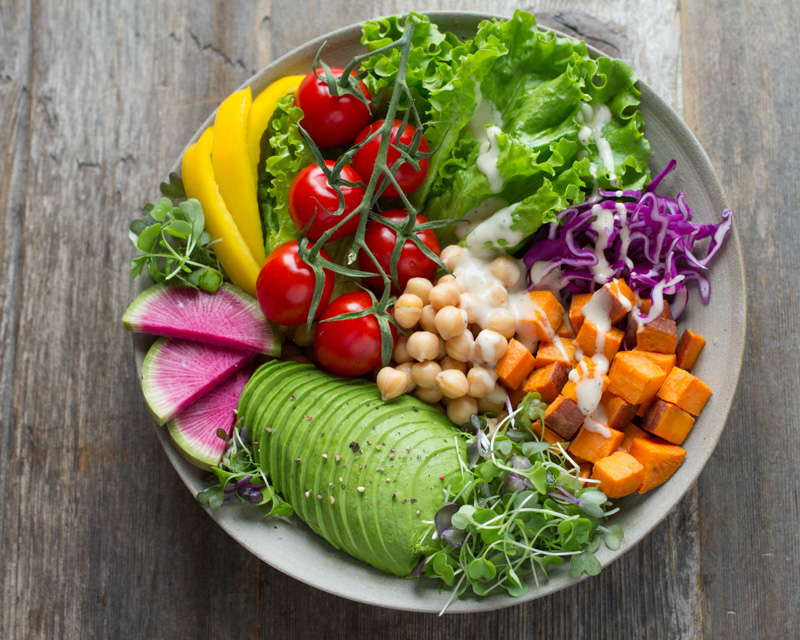FODMAPs
As anyone that has followed the low FODMAP diet knows, FODMAP-containing foods can be hard to avoid. Foods that normally form part of a healthy balanced diet, like dairy products and a wide variety of fruits and vegetables, often also contain FODMAPs. Studies have shown that although maintaining adequate nutrition on a low FODMAP diet is challenging, it is possible with the right advice. However, this does not mean you should remain in the restriction phase of the diet any longer than needed. Finding your triggers and personal tolerance for them is so important.
When it comes to changing your diet it’s important to remember that you are eating for your gut microbes as well as for yourself. The ‘O’ in FODMAP stands for oligosaccharide. These are a family of carbohydrates that our gut microbes thrive on. So, reducing their intake can have unforeseen knock-on effects. On top of this, it is well documented that having as diverse a diet as possible is key to good gut health.
What’s the deal with dietary diversity?
The health of all ecosystems depends on diversity, and our gut microbiome is no different. Good gut health is intrinsically linked to overall health. This is because our gut bacteria perform a variety of key functions. They can help us extract more energy from hard-to-digest fibers. The substances they produce during this process help our digestive, immune, and nervous systems. They also produce micronutrients that maintain our health, and hormones that affect our mood and protect us from harmful bacteria. Studies have shown that more diverse diets lead to healthier and more resilient gut microbiomes.
Unfortunately, it is not always easy to maintain a diverse diet. 75% of the food produced in the world comes from only 12 plant and 5 animal species. Based on a large US study that measured microbiome samples from over 10,000 people, some nutrition experts now recommend eating 30 or more plant-based foods per week for optimum gut microbe diversity. Researchers also believe that a loss of gut microbiome diversity due to Western-style diets (high in simple or refined carbohydrates; low in fiber and micronutrient density) can increase the risk of developing various conditions, including digestive, metabolic, and cardiovascular disorders.
While the causes of IBS are extremely complex and not fully understood, people with IBS have been shown to have less diverse and less stable microbiomes. An imbalance in the gut ecosystem is thought to be a key factor.
So, what happens to our gut microbes when we reduce our FODMAP intake?
Our environment influences the composition of our gut microbiome far more than our genetics, with diet contributing up to 20% of the variation between individuals. So, as you might expect, when you remove an element of your diet that your gut microbes like to eat (like oligosaccharides) this has a knock-on effect on your gut microbiome. This can happen quickly, with dietary changes being reflected in gut microbiome samples within 24 hours.
The short-term effect of reducing FODMAP intake on gut bacteria has been explored since the introduction of the diet. It has been shown that in some cases the total amount of bacteria is reduced, while in others it remains unchanged. A more consistent finding is that the types of bacteria change. For example, the abundance of a type of bacteria known as Bifidobacteria is consistently reduced.
One study showed that a 50% reduction in FODMAPs led to a 6-fold reduction in Bifidobacteria. This may be problematic as these bacteria are considered “gut-friendly” and are known to have a range of health benefits. In fact, people with IBS have been shown to have less Bifidobacteria generally. This leads to a paradoxical situation where a modified diet can provide short-term symptom relief, but potentially deplete an already imbalanced gut ecosystem in the long term. This illustrates the importance of finding a diet that doesn’t cause symptoms but can still maintain ongoing gut health.
Find your FODMAP tolerance levels
A key takeaway is that you should think about how to reduce your FODMAP intake to levels you can tolerate, rather than eliminating a particular FODMAP completely. Most people should be able to tolerate some level of each FODMAP.
Another key takeaway is that our gut microbiome needs as much dietary diversity as possible. So, try to find as many different plant-based, fiber-containing foods as you can that don’t cause symptoms and work these into your everyday diet.
A good place to start is with the FoodMarble Food Intolerance Testing Kit. You can use this along with your AIRE or AIRE 2 to test your tolerance to a range of FODMAPs. If you find a particular FODMAP causes a lot of fermentation for you, you can use the FoodMarble app to track your response to smaller amounts rather than eliminating it completely. The FoodMarble Food Library can also help you gauge the FODMAP levels in a wide variety of everyday foods. Ultimately the aim is to build up your own personal Food Library with as much diversity as possible. You will eventually get to a point where you are thinking about what you can eat rather than what you can’t!



















